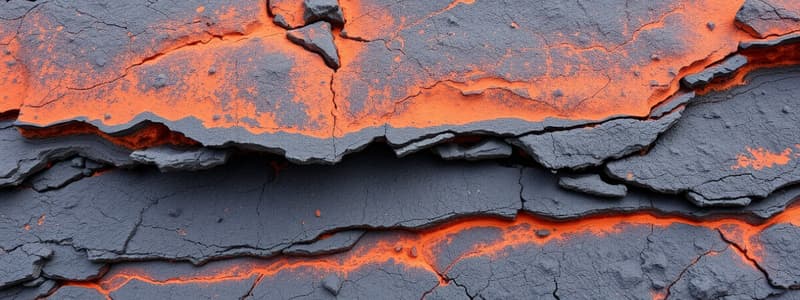Podcast
Questions and Answers
What is petrology?
What is petrology?
The study of rocks and the conditions under which they form.
Which of the following are types of magma?
Which of the following are types of magma?
- Ultramafic (correct)
- Mafic (correct)
- Sedimentary
- Intermediate (correct)
Decompression melting occurs when the temperature of magma decreases.
Decompression melting occurs when the temperature of magma decreases.
False (B)
Match the following types of igneous rocks with their characteristics:
Match the following types of igneous rocks with their characteristics:
What is Bowen's Reaction Series?
What is Bowen's Reaction Series?
What are intrusive igneous structures?
What are intrusive igneous structures?
What is Petrology?
What is Petrology?
What are the main types of rocks?
What are the main types of rocks?
What is the rock cycle?
What is the rock cycle?
What is magma?
What is magma?
Which of the following are types of magma?
Which of the following are types of magma?
What is decompression melting?
What is decompression melting?
What are magmatic processes?
What are magmatic processes?
What does Bowen's Reaction Series describe?
What does Bowen's Reaction Series describe?
Ultramafic rocks contain a high amount of silica.
Ultramafic rocks contain a high amount of silica.
What characterizes mafic rocks?
What characterizes mafic rocks?
What is an intrusive igneous structure?
What is an intrusive igneous structure?
Flashcards are hidden until you start studying
Study Notes
Petrology Overview
- Petrology is the study of rocks, including their origins, composition, and transformation.
- Rocks are classified into three main types: igneous, sedimentary, and metamorphic.
Rock Cycle
- Rocks continually change from one type to another in the rock cycle, influenced by geological processes.
- Each rock type can be transformed into another through processes such as melting, erosion, and metamorphism.
Igneous Petrology
- Igneous rocks form from the solidification of magma or lava.
- Types of igneous rocks are categorized based on their mineral composition and texture.
Magma Characteristics
- Magma is molten rock beneath the Earth's surface and is the source of igneous rocks.
- Types of magma are classified based on silica content: ultramafic, mafic, intermediate, and felsic.
Temperature and Magma
- Temperature increases with depth in the Earth, influencing the melting of rock.
- Decompression melting occurs when pressure decreases on rocks, allowing them to melt without temperature changes.
- Addition of volatiles (e.g., water, carbon dioxide) lowers the melting point of rocks, resulting in magma formation.
Magmatic Processes
- Magmatic processes involve how magma forms, differentiates, and solidifies into igneous rocks.
- Processes include fractional crystallization, assimilation, and magma mixing which affect the composition of the resultant rocks.
Magma Series and Differentiation
- Magma series help classify different types of magma, aiding in understanding their characteristics and origins.
- Bowen’s Reaction Series outlines the sequence of mineral crystallization from cooling magma, illustrating how different minerals form under various conditions.
Igneous Composition
- Ultramafic: Contains very low silica content, high in magnesium and iron.
- Mafic: Rich in iron and magnesium, with moderate silica content.
- Intermediate: Balanced silica content, between mafic and felsic.
- Felsic: High in silica, containing lighter minerals like quartz and feldspar.
Intrusive Igneous Structures
- Intrusive igneous structures form when magma cools and solidifies beneath the Earth’s surface.
- Examples include batholiths, stocks, sills, and dikes, which vary in size and orientation.
Key Terms
- Decompression Melting: Melting due to a reduction in pressure.
- Volatiles: Elements or compounds that vaporize or release gases, influencing magma formation.
- Fractional Crystallization: Process where different minerals crystallize from magma at different temperatures.
Petrology Overview
- Petrology is the study of rocks, including their origins, composition, and transformation.
- Rocks are classified into three main types: igneous, sedimentary, and metamorphic.
Rock Cycle
- Rocks continually change from one type to another in the rock cycle, influenced by geological processes.
- Each rock type can be transformed into another through processes such as melting, erosion, and metamorphism.
Igneous Petrology
- Igneous rocks form from the solidification of magma or lava.
- Types of igneous rocks are categorized based on their mineral composition and texture.
Magma Characteristics
- Magma is molten rock beneath the Earth's surface and is the source of igneous rocks.
- Types of magma are classified based on silica content: ultramafic, mafic, intermediate, and felsic.
Temperature and Magma
- Temperature increases with depth in the Earth, influencing the melting of rock.
- Decompression melting occurs when pressure decreases on rocks, allowing them to melt without temperature changes.
- Addition of volatiles (e.g., water, carbon dioxide) lowers the melting point of rocks, resulting in magma formation.
Magmatic Processes
- Magmatic processes involve how magma forms, differentiates, and solidifies into igneous rocks.
- Processes include fractional crystallization, assimilation, and magma mixing which affect the composition of the resultant rocks.
Magma Series and Differentiation
- Magma series help classify different types of magma, aiding in understanding their characteristics and origins.
- Bowen’s Reaction Series outlines the sequence of mineral crystallization from cooling magma, illustrating how different minerals form under various conditions.
Igneous Composition
- Ultramafic: Contains very low silica content, high in magnesium and iron.
- Mafic: Rich in iron and magnesium, with moderate silica content.
- Intermediate: Balanced silica content, between mafic and felsic.
- Felsic: High in silica, containing lighter minerals like quartz and feldspar.
Intrusive Igneous Structures
- Intrusive igneous structures form when magma cools and solidifies beneath the Earth’s surface.
- Examples include batholiths, stocks, sills, and dikes, which vary in size and orientation.
Key Terms
- Decompression Melting: Melting due to a reduction in pressure.
- Volatiles: Elements or compounds that vaporize or release gases, influencing magma formation.
- Fractional Crystallization: Process where different minerals crystallize from magma at different temperatures.
Studying That Suits You
Use AI to generate personalized quizzes and flashcards to suit your learning preferences.




